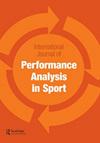Variability of test match cricket and the effects of match location on physical demands in male seam bowlers
IF 1.6
4区 教育学
Q1 Health Professions
International Journal of Performance Analysis in Sport
Pub Date : 2022-03-04
DOI:10.1080/24748668.2022.2051924
引用次数: 2
Abstract
ABSTRACT The physical demands of test match cricket in seam bowlers during fielding are currently unknown. Similarly, analysis of between-match variability and the effects of playing home vs. away is required. Nine international male seam bowlers across 28 test matches (n = 9 home; n = 19 away) were investigated over five years (2015–2019). Seam bowlers wore global positioning sensors during match play fielding to quantify physical demands. Absolute and relative (per hour) distances covered in five velocity bands, total distance, and number of accelerations and decelerations were assessed for each match. Coefficient of variation (CV%) and smallest worthwhile change were used to calculate between-match variability. Mixed linear modelling was used to analyse home vs away matches. Seam bowlers covered up to 50 km, with maximal durations of >21 hours during test match fielding. Small between-match CV% (8.3) were found for maximal velocity with large (CV% = 21–192) between-match variability across most other variables. Greater distances were covered at 15–20 km·h−1 (p = 0.02) and >25 km·h−1 (p = 0.04) when playing at home. The results demonstrated substantial, highly variable physical demands. Practitioners should adapt training retrospectively to the match demands encountered and should anticipate that match intensity may be higher during home matches.板球比赛的变异性和比赛地点对男缝保龄球运动员身体需求的影响
摘要:板球测试赛中接缝投球手在防守过程中的身体需求目前尚不清楚。同样,需要分析比赛之间的可变性以及主客场比赛的影响。在五年(2015-2019)的时间里,对28场测试赛中的9名国际男接缝投球手(n=9主场;n=19客场)进行了调查。接缝投球手在比赛中佩戴全球定位传感器,以量化身体需求。评估了每场比赛在五个速度带内的绝对和相对(每小时)距离、总距离以及加速和减速次数。变异系数(CV%)和最小有价值的变化用于计算匹配之间的变异性。混合线性模型被用来分析主客场比赛。接缝投球手的投球距离可达50公里,在测试赛防守期间,最长持续时间超过21小时。最大速度的匹配间CV%较小(8.3),而大多数其他变量的匹配间变异性较大(CV%=21-192)。在家比赛时,15–20公里·小时-1(p=0.02)和>25公里·小时−1(p=0.04)的距离更大。研究结果显示了大量的、高度可变的身体需求。练习者应根据遇到的比赛需求对训练进行回顾性调整,并应预计主场比赛的比赛强度可能会更高。
本文章由计算机程序翻译,如有差异,请以英文原文为准。
求助全文
约1分钟内获得全文
求助全文
来源期刊

International Journal of Performance Analysis in Sport
SPORT SCIENCES-
CiteScore
4.70
自引率
4.80%
发文量
38
审稿时长
>12 weeks
期刊介绍:
The International Journal of Performance Analysis in Sport aims to present current original research into sports performance. In so doing, the journal contributes to our general knowledge of sports performance making findings available to a wide audience of academics and practitioners.
 求助内容:
求助内容: 应助结果提醒方式:
应助结果提醒方式:


